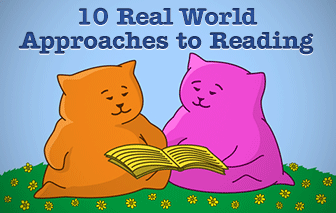Let's Face It: Some Kids Just Donít Like To Read: 10 Simple Ways To Foster A Love For Reading In Your Young ESL Students


Some ESL students, however, may not be drawn to reading. They struggle with English spelling and text laden pages, and discouragement defeats engagement as they close the book. Your ESL students do not have to fight this inner battle with book in hand. You can encourage them to read and at the same time foster a love of reading within them. Here are some easy strategies you can use in your classroom to encourage reading and all the benefits that go along with it.

Students who read are better learners, so fostering a love of reading in your students is important for their long term success. By setting aside a specific time each day for independent reading, your students will know that reading is important. To start a drop everything and read session (DEAR) in your classroom, tell students that everyone, you included, will stop everything and read later that day. Have students choose a book that they will read during DEAR before the DEAR period starts. Then, starting with a 5 minute session and growing longer as the semester progresses, everyone drops everything and reads. You may even want to put a do not disturb sign on your classroom door. Tell your students that no one is to talk or ask questions (though dictionary is okay) or move around the room while they read.
Reading does not have to be all about internalizing language. Your students can read aloud in a theater simulation, engaging their speaking and pronunciation. You choose from several scripts for your students to use in their productions. To prepare, make a copy of the script for each member of the play. Highlight each part on its own copy. Then give your students time to read and prepare their play before presenting it to the class. It is up to you whether you want students to use props or costumes, but the important thing is that they are reading aloud when they give their presentation. Giving them an opportunity for theater production may be just the motivation your ESL students need to read in front of their classmates and have fun in the process!
Book clubs have been popular for a long time. There is just something unique about discussing your thoughts on what someone else has written. Give your students a chance to have their own book discussions with literature circles. You may want to assign the same book to 4 or 5 students in the same literature circle, or have your students read different books on the same theme. Students should read their books independently, making notes of anything they might like to share with their circle. Then, give them time to discuss what they have read during class. You might want to give your groups some starter questions like the following.
Reading aloud to your students is another great way of increasing interest in reading. It shows your class that you value reading, enough to take time from class every day to make it happen. Reading aloud also helps your students increase their reading comprehension. For some students, listening to a teacher read lines up with their learning styles better than words on a page do. For others, just hearing your pronunciation and inflection will make them better speakers of English. Reading aloud also alerts your students to good books that they may want to read on their own, particularly if you include DEAR sessions in your daily routine. So don’t depend solely on the librarian to read aloud to your students. Take some time each day to read exciting books to your class, and they will never forget it!
Getting your students to write about the books that they read is another way to increase their love for the written word. Having the whole class read one book together gives them a shared experience and can give you an opportunity to have a lively discussion in class. You can also assign students to read books at home, with parents, either student reading aloud to parents or parents reading aloud to students, for about 15 minutes each night. The students can then write about what they read in their reading journal. Stress to your students that you do not want them to simply write a summary of what they read. They should relate what they read to their real life experiences. This personal connection with the book will give students a more positive and emotional connection with reading.
Particularly with ESL students, providing every opportunity to have conversation with native speakers is essential. You can schedule reading dates (something akin to a play date) in which another class in the school visits your class. Have them bring books with them or supply them with books your class has chosen. Then let students pair together, one from each class, and read to one another. If your class buddies with an older class, they will see that reading is valuable to older students and will look to them as role models. If your class partners with younger students, they will be less intimidated when they read and can practice having conversations with young children, a challenge no matter what your first language is.
Today, many books are available in audio form. Whether you purchase these from a bookstore or online music service or borrow CD's from the library, your students will benefit from having audio books available in the classroom. Listening can be less intimidating than reading, especially if a book is long or seems long to your students. Your students may choose more challenging texts than they otherwise would if they can listen to the audio version. In addition, your ESL students will get more comprehension clues as they come through the reader’s voice on the CD. Audio books also help with vocabulary development, and may be easier to understand if a student’s listening vocabulary is greater than his reading vocabulary, which often happens with ESL students.
Reading does not have to be limited to what is in the literature book. Reading is important for every area of learning, and content area reading material shows your students that there is a greater purpose in reading. They realize that they can read to learn and not just learn to read. For ESL students, content area reading material is particularly useful since your students often know the content though they may not know the language used to express it. This advance knowledge on the content will make reading comprehension easier for your students and may encourage them to keep reading.
Do your students read different genres? Do you introduce different types of reading material throughout the semester? If you do, teaching your students how to classify that material into the different genres may help them become better writers. When your students see the characteristics that define a piece of literature, they will learn to incorporate these characteristics in their own writing. As you read material throughout the semester, show your students what qualities it has that make it fit into a particular genre. Then have your students keep a record of those characteristics in a reading or writing notebook. The next time you assign a piece of writing that fits into a particular genre, have your students bring out their lists to consider as they write.
Children learn what they see. When reading is important to you, reading will be important to them as well. Take regular opportunities to read in front of your class, both aloud and silently as they read. As their love and respect for you grows, as it undoubtedly will, so will their love for reading.
How do you foster a love of reading in your students?